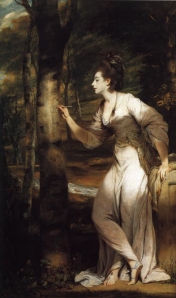Originally posted at Patell and Waterman’s History of New York.
Our latest Networked NY Q&A is with Reed Gochberg, a doctoral student in English at Boston University. Reed studies late nineteenth-century American literature and culture and her research interests include American intellectual history and urban cultural history.
Your paper at Networked New York offered a re-reading of the tableaux vivant in The House of Mirth, which you place in the context of New York cultural institutions established in the final decades of the nineteenth century. What are the key elements of this historical moment and these cultural institutions that you see at work in Wharton’s novel?
I first began considering these ideas after visiting an exhibit at another New York institution this past November: the “Beauties of the Gilded Age” series at the New-York Historical Society, which showcases (on rotation) the miniature collection of Peter Marié. Marié was a bachelor who commissioned miniatures of beautiful New York women (including Edith Wharton) and amassed a collection of over three hundred such portraits. On visiting the exhibit, I was immediately reminded of Edith Wharton’s The House of Mirth and its famous tableaux vivant scene, in which the protagonist, Lily Bart takes part in an “entertainment” staged by a wealthy New York family in their Fifth Avenue mansion. As one of twelve performers in tableaux vivant, she appears as Joshua  Reynolds’ painting, Mrs. Lloyd, in a striking display that showcases both her beauty and her ability to become an art object (see image at left). I was struck by the seeming reversal of such a process: photographs of women transformed into miniatures, as opposed to women transforming themselves into paintings.
Reynolds’ painting, Mrs. Lloyd, in a striking display that showcases both her beauty and her ability to become an art object (see image at left). I was struck by the seeming reversal of such a process: photographs of women transformed into miniatures, as opposed to women transforming themselves into paintings.
The cultural context of the novel definitely suggests its interest in cultural institutions, especially given the historical proximity of its publication (1905) to the founding of the Metropolitan Museum of Art (1870) and other contemporaneous institutions. On further reading of the tableaux vivant scene, other inversions present themselves: rather than a museum where art objects are displayed, Wharton describes a ballroom transformed, temporarily, into a theater/gallery. And more importantly, rather than directing their money to philanthropic purpose—and particularly, supporting the public arts—her wealthy characters are throwing a private party. When read in light of these broader philanthropic networks, the scene suggests a powerful commentary on an important moment for cultural institutions in America—and an issue that’s continually relevant to today’s debates about the funding of the arts.
What relationships between and among authorship, institutions and philanthropy at the turn of the twentieth century do the art scenes in The House of Mirth establish?
I think that the tableaux vivant scene registers the importance of beauty in the novel, on a much deeper level than Jonathan Franzen’s purely cosmetic interpretation of Wharton in a recent New Yorker piece would imply. By examining this moment in the context of New York’s cultural institutions, I find that this idea of beauty takes on a much broader meaning, beyond the personal beauty of Lily Bart, which extends to interrogations of the city itself and the cultural opportunities that it provided at the turn of the century. In her memoir, A Backward Glance, Wharton laments the “intolerable ugliness of New York” as a creative environment; similarly, Lily famously hates “dinginess” and spends much of the novel trying to avoid it. In her book, The Decoration of Houses and all of her novels, Wharton emphasizes the importance of cultural spaces that encourage creative work, rather than stifle it. This concern was shared with many of her contemporaries, and this context opens up a range of comparisons to other novels that more explicitly consider visual art, connoisseurship, and philanthropy from this era, including Henry James’s The Golden Bowl or William Dean Howells’s The Rise of Silas Lapham.
What immediate questions or concerns did you take away from the conference?
At the conference, I presented with Kristen Highland and Joey McGarvey on the “Institutions and Enterprise” panel. While I was thinking about the museum as a public space in my paper, it was quite interesting to hear about their projects on more explicitly literary spaces, such as a bookstore or a fruit festival. By putting these different projects into conversation, it raised a number of questions for me about the relationship between the visual and literary arts at the turn of the century, especially for realist authors: an idea that was particularly well voiced by Tom Augst in his response to our panel. Additionally, our discussions suggested new ways of considering the role of institutions in creating a newly public, social space for cultural experiences, whether literary, visual, or musical.
The conference as a whole did an excellent job of bringing together a number of different perspectives on the spaces of New York. From our panel on institutions to the closing discussion between New York bloggers, it suggested a number of approaches to understanding how the evolving landscape of a city inspires different forms of written representations. Moreover, the conference demonstrated the variety of approaches to preserving the energy of New York, both within and beyond the traditional archive: architecturally, through preservation, registry, or even re-creation (as in the Vault at Pfaff’s); or interpersonally, through digital maps of nineteenth century networks.


